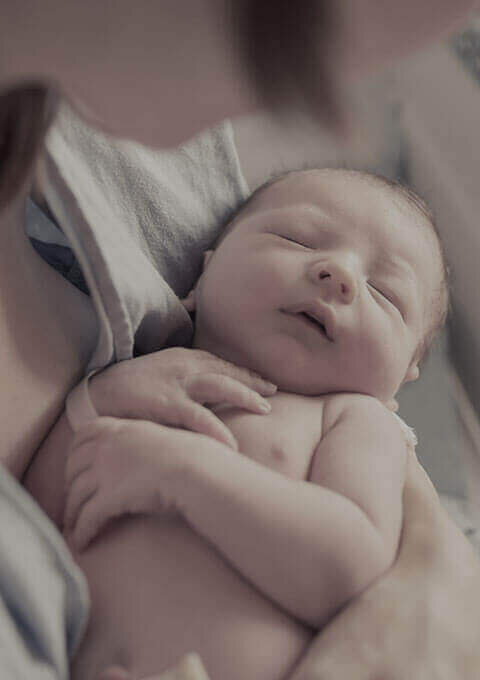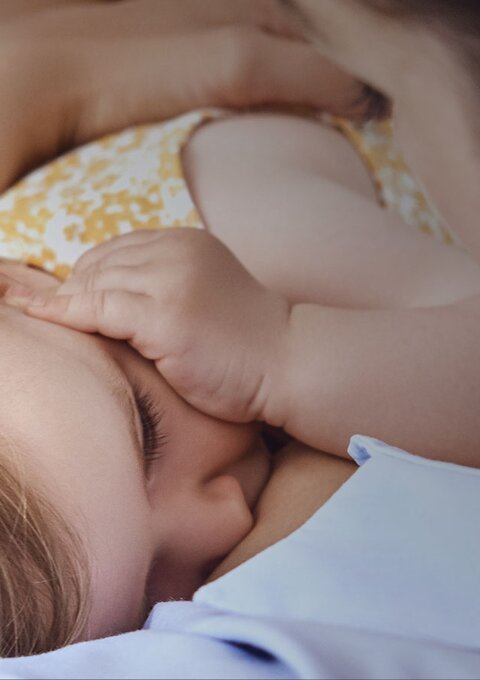"Can I breastfeed after a C-section? Will I have milk? Will my baby know how to suck?" These questions often trouble future mothers with an elective C-section. We would like to convince you that a C-section is not an obstacle to breastfeeding.
Consultation: Agata Serwatowska-Bargieł Ph.D., International certified lactation consultant (IBCLC), neonatologist
The way in which you give birth is not a factor decisive for breastfeeding, as your body prepares for breastfeeding much earlier. Already around gestational, 16 week your breasts start to prepare for milk production and secretion. This is caused by increased levels of prolactin, responsible for milk production in lactiferous alveoli. Birth of the placenta is a final signal for the body to start the "milky way". With the birth of the placenta, woman's progesterone levels, blocking milk production and secretion during the pregnancy, drop significantly. At the same time, prolactin secretion is intensified, together with other hormonal changes stimulating lactation.
The C-section is an interference in a natural course and process of birth, so there may be a delay in your body's response, but it will respond, because it is not the childbirth type but the placenta removal which is a basic signal stimulating lactation.
The answer is clear - as soon as you can. Kangaroo care, that is "skin to skin" contact, and first breastfeeding within the first hour of the baby's life is the ideal situation. However, it is rarely possible after a C-section, due to a condition of the mother or the newborn.
A C-section is a surgery during which the abdomen is open, performed in anesthesia. If you can choose, we would recommend a perineural anesthesia (spinal block), and not a general one. With this anesthesia, operating from the waist down, you will remain conscious and probably you will be able to hold your baby for the first feeding, with a help from a midwife or somebody close to you, already shortly after the procedure.
At the beginning of lactation, regardless of a type of birth, the breasts will secrete colostrum. This thick yellow secretion is a very important first milk rich in antibodies and immune cells. This first milk is particularly important for children born through a C-section, whose skin and digestive tract could not absorb bacterial flora from mum's birth canal.
Sometimes, after a C-section the baby has to be separated from his mum for some time. Then it is important to stimulate lactation with a breast pump. To maintain lactation, you should extract milk every two–three hours (at least 8 times per 24 hours). At the beginning, the quantities will be minimum, but this is normal and you should not be discouraged by this. During the first hours after birth the baby still has energy resources from his fetal life. But in time, milk extraction will stimulate lactation and the amount of milk will increase. If you can extract milk near your baby, do so, as the sight of the baby will stimulate lactation.
Latching on to the breast, even when the baby does not suck much, can do wonders to stimulating lactation. The sight of the baby alone, the sound of his crying, and particularly the embrace is a strong stimuli for milk production. Even when the baby is in an incubator, talk to a doctor about a possibility of feeding him naturally. Maybe his condition is good and stable enough to allow you latching him on to the breast for several minutes. And even when it is still impossible, spend as much time as you can with him; maybe you can put your hand into the incubator to caress him, or just look at him and tell him that you will soon be together.
It is worth getting through this time of separation actively working on lactation. Mother's milk is the best thing you can give to the baby with health problems, and with assistance from doctors or midwives he can receive it through a tube, pipette or bottle with an appropriate teat, which will not disturb a natural suckling rhythm and reflex.
Production of milk is strongly related to sensory stimuli the baby sends to his mum when suckling. Sensory stimuli sent to mum's pituitary gland release prolactin responsible for milk production and oxytocin ensuring milk letdown. The more frequent and longer you feed, the more sensory stimuli the baby sends, and so the amount of produced milk also increases. However, when bottle feeding is necessary, production of milk must be stimulated with a breast pump.
The majority of babies are born with the suckling reflex developed. This skill develops already during pregnancy, and around week 17 the baby sucks his thumb or another finger. The skill of suckling coordinated with swallowing and breathing develops fully around gestational week 32 and 34.
The C-section can however result in a temporary weakening of the suckling reflex, and the baby will not want to suck. He can be tired, sleepy or his gag reflex can be activated following removal of mucus after birth. Do not lose your head and do not give up, usually patient and delicate attempts to latch the baby on to the breast bring about the desired result. You should remember that during these difficult moments you do not have to be on your own. We really encourage you to benefit from assistance and support of a lactational advisor.
When choosing a comfortable breastfeeding position after a C-section, you should consider a few issues:
baby's position cannot irritate the wound on your belly;
your physical condition, mobility and ability to move probably will not be good, and each move will cause pain;
you may need assistance to place the baby.
During first hours after the C-section you will have to lie on your back. At that time, the best option is asking a midwife to help you to latch the baby on to your breast. She will help you to place the baby on your belly, with his head at a level with your breast and his mouth on the nipple. This position is called the Australian hold. In this position you can embrace your newborn treasure with your arm and enjoy the first moments of closeness.
With time, when the mum's ability to move increases, a good position is lying on a side. It is very comfortable in a hospital, while you recover from your surgery.
For women who can already sit up, an underarm position is a good solution. The baby is at the mum's side, so the surgery wound is safe. This position is also recommended when learning breastfeeding, and both you and your baby are still learning it. In this position it is easy to latch the baby on to the breast correctly, so the nipple with a part of areola is in the baby's mouth.
At standard doses, painkillers are safe for the baby and their use does not have to be limited. The amount of milk during the first days after childbirth is small and the newborn will really get just traces of a medicine. Mums feeling pain after the surgery but refusing painkillers (first, ketoprofen, and later ibuprofen or paracetamol) for the baby's sake can experience problems with lactation, as pain and tiredness inhibit milk letdown.
During feeding the baby sometimes swallows air that accumulates in the digestive tract and can cause colic, bloating and posseting. Therefore, after each feeding you should encourage your child to burp. We show 3 burping ...
What is the difference between colostrum and the proper milk? How to latch? We ask ourselves these questions at the beginning of feeding. Here you will find the answers.
Delivery by Caesarean section, also known as a C-section, differs significantly from a natural birth. This is associated with the differences in the postpartum recovery, such as scare care. Learn about the postpartum period ...
You are expecting a baby and want to breastfeed, or maybe you have already started this exceptional adventure, but your head is full of questions and doubts, as in many cases it is not an easy and problem-free task. We will ...
Can I breastfeed after a C-section? Will I have milk? Will my baby know how to suck?" These questions often trouble future mothers with an elective C-section. We would like to convince you that a C-section is not an obstacle ...
Breastfeeding is a wonderful gift that nature gave to women. A gift both for the child and for mothers themselves. Explore the benefits of breastfeeding.
During infection, breast-feeding is advisable, even during fever and runny nose. It protects the baby against infection. However, there are diseases that prevent breast feeding. Check when you can, and when you should not ...


